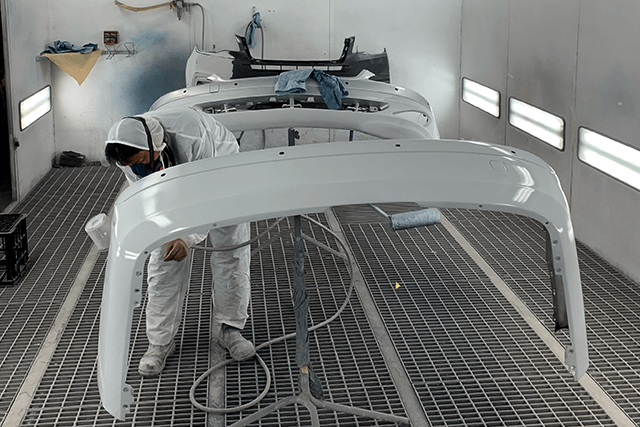How to inspect a car paint job
Matilda Douglas-Henry
Whether your vehicle has been repainted or you’re buying a used car, knowing how to inspect a car’s paint job is a valuable asset. This article will discuss the tips and tricks on assessing the quality of a paint job, including:
- The makings of a good paint job vs. an underwhelming one
- Why it’s important to inspect your car’s paint job
- Tips for a good at-home assessment
- How to ensure a good paint job

How can I tell if my car’s paint job is good, and how can I tell if it’s below average?
A good car repaint requires hours of work, so it’s important to leave it up to professionals who have the knowledge and skill to execute it.
Not only does the painting itself take a long time, but the prep work is massive: a car must be sanded and cleaned in multiple rounds to ensure that no imperfections will appear during the painting process. Primer and sealer will also be applied prior to painting, which plays a major role in the longevity of the paint job.
We will get into how to inspect your paint job in greater detail later in the article, but you can make some initial observations at first sight too.
A high-quality paint job will obviously look the part: your car’s panels should be smooth and have a nice shine, and the paint will be of consistent thickness and evenly distributed across the exterior of the vehicle. The paint will also be the exact same colour as the original paint job (unless, of course, you decided to change it). There should be no dust and debris gathering on the panels.
A bad paint job will be coarse and unevenly distributed across the panels, and might have some debris or dust trapped under one of the layers. The paint may not be a specific colour match and won’t blend in with surrounding panels. Dirt spots and overspray are two telltale signs of an amateur repaint.
Why is it important to inspect my car’s paint job?
Paint jobs aren’t cheap, so you want to make sure that you are getting bang for your buck. Regularly repainting your car at a high standard can add years to the aesthetic and resale value of your vehicle.
A bad paint job, on the other hand, can diminish your car’s quality, as well as kill your confidence when you take it out for a drive. It’s important to be proactive and identify any potential issues with your paint job ASAP, so you can promptly inform the repairer and return your car to the shop.
If you are buying a used car, it’s all the more essential to inspect the car’s paint job. Regardless of its face-value quality, knowing how to assess the paint job will allow you to determine whether or not the car has been damaged in the past. You want to make sure that you’re purchasing the vehicle at a fair price, and if there’s any chance that you’ll soon have to get a full body respray you have solid grounds to negotiate.
How to inspect your car’s paint job
It’s easy enough to conduct a thorough at-home assessment of your car’s paint job, and it’s a valuable skill to have.
The first step is simple: make sure that you have a good lighting setup. You won’t be able to determine the quality of the paint job in a dark garage or at night. Look at the paint during the day when it’s sunny, or invest in a paint inspection light. They don’t cost you much, and are especially helpful in revealing scratches and paint swirls which you might not be able to see otherwise*.
Paint thickness is another good way to determine the quality of the paint job, and is particularly useful if you are buying an old car. The paint thickness will tell you how much paint and clear coat is left on the car’s surface, which will allow you to figure out when you will need to repaint. The most specific way to figure this out is by using a paint thickness gauge.
A helpful DIY method is the plastic bag test: put one over your hand and run it across the surface of the car. The plastic heightens sensitivity and will allow you to feel small bumps which are contaminants—usually debris—that are embedded in the paint and won’t come off by simply washing your car*.
How to ensure a good paint job
If you are getting your car repainted, do your homework: find a reliable and trustworthy service that can get you the result you want. Do not try to do it yourself unless you have the experience and tools required, and are confident that you can execute it at a high standard*.
Do not settle for a cheaper paint that looks the same colour as the one on your vehicle; trust us, it’s not as similar as it seems! You need a specific paint match so that it blends with surrounding panels and looks as good as new.
Conclusion
Now that you have an understanding of how to inspect a paint job, you can put your skills to the test the next time you’re in the market for a repaint, or if you’re buying a used car. For all your professional car repainting and panel beating needs, use DingGo’s quick quotes service today.
